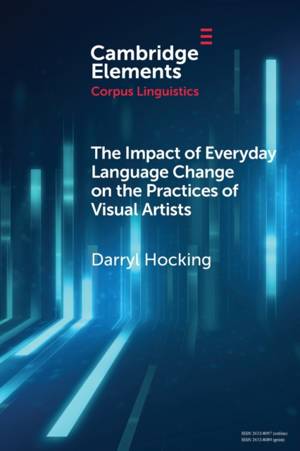
Door een staking bij bpost kan je online bestelling op dit moment iets langer onderweg zijn dan voorzien. Dringend iets nodig? Onze winkels ontvangen jou met open armen!
- Afhalen na 1 uur in een winkel met voorraad
- Gratis thuislevering in België vanaf € 30
- Ruim aanbod met 7 miljoen producten
Door een staking bij bpost kan je online bestelling op dit moment iets langer onderweg zijn dan voorzien. Dringend iets nodig? Onze winkels ontvangen jou met open armen!
- Afhalen na 1 uur in een winkel met voorraad
- Gratis thuislevering in België vanaf € 30
- Ruim aanbod met 7 miljoen producten
Zoeken
The Impact of Everyday Language Change on the Practices of Visual Artists
Darryl Hocking
€ 31,95
+ 63 punten
Omschrijving
The practices of visual artists can never be decontextualised from language. Firstly, artists are constantly in dialogue with their peers, dealers, critics, and audiences about their creative activities and these interactions impact on the work they produce. Secondly, artists' conceptualisations of what artistic practice encompasses are always shaped by wider social discourses. These discourses, however, and their manifestation in the language of everyday life are subject to continual change, and potentially reshape the way that artists conceptualise their practices. Using a 235,000-word diachronic corpus developed from artists' interviews and statements, this Element investigates shifts in artists' use of language to conceptualise their art practice from 1950 to 2019. It then compares these shifts to see if they align with changes in the wider English lexicon and whether there might be a relationship between everyday language change and the aesthetic and conceptual developments that take place in the art world.
Specificaties
Betrokkenen
- Auteur(s):
- Uitgeverij:
Inhoud
- Aantal bladzijden:
- 75
- Taal:
- Engels
- Reeks:
Eigenschappen
- Productcode (EAN):
- 9781009225731
- Verschijningsdatum:
- 19/05/2022
- Uitvoering:
- Paperback
- Formaat:
- Trade paperback (VS)
- Afmetingen:
- 152 mm x 229 mm
- Gewicht:
- 140 g

Alleen bij Standaard Boekhandel
+ 63 punten op je klantenkaart van Standaard Boekhandel
Beoordelingen
We publiceren alleen reviews die voldoen aan de voorwaarden voor reviews. Bekijk onze voorwaarden voor reviews.











